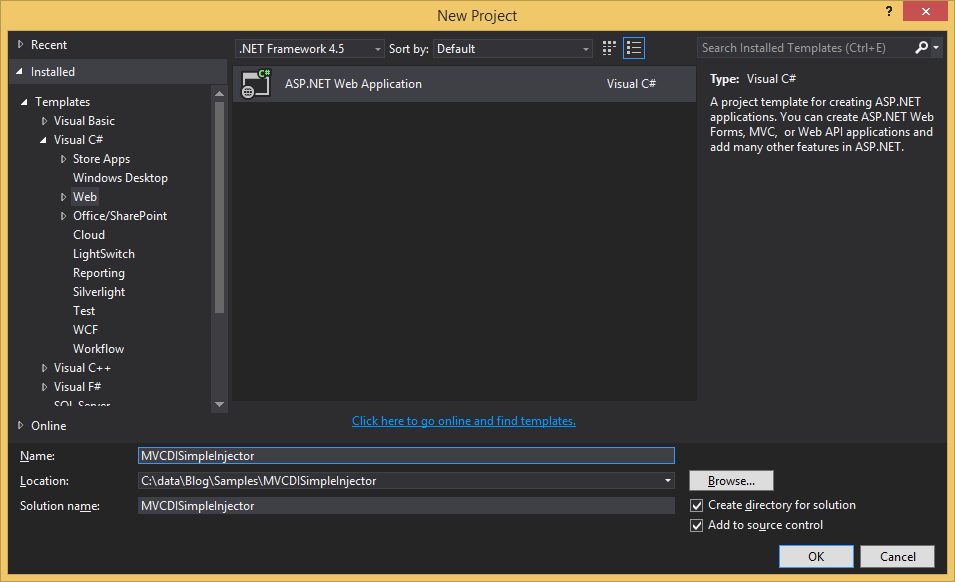I have been learning SimpleInjector for few days and it’s just awesome. I have already written two post about it(see below link) and this post will be third post about it. In this post we are going to learn how we can do Dependency Injection with ASP.NET MVC.
For those who are reading my posts about Simple Injector Followings are two previous post I have written about Simple Injector. I highly recommend to read first two post so that you can be aware about how we can configure SimpleInjector container.
Dependency Injection with Simple Injector
Singleton Instance in Simple Injector
So let’s start with creating a ASP.NET MVC Project from Visual Studio.

There is already nuget package created for ASP.NET MVC Integration available so you can install that via following nuget command.
1.Install-Package SimpleInjector.Integration.Web.Mvc01.namespace MVCDISimpleInjector.Models02.{03.public class Customer04.{05.public int Id { get; set; }06.public string FirstName { get; set; }07.public string LastName { get; set; }08.}09.}
Now let’s write a repository interface and repository class for the Customer Model Class.
01.using System.Collections.Generic;02. 03.namespace MVCDISimpleInjector.Models04.{05.public interface ICustomerRepository06.{07.List<Customer> GetCustomers();08.}09.}
Here is a implementation of ICustomerRepository interface.
01.using System.Collections.Generic;02. 03.namespace MVCDISimpleInjector.Models04.{05.class CustomerRepository : ICustomerRepository06.{07.public List<Customer> GetCustomers()08.{09.var customers = new List<Customer>10.{11.new Customer{Id=1,FirstName = "Jalpesh", LastName = "Vadgama"},12.new Customer{Id=2,FirstName = "Vishal",LastName = "Vadgama"}13.};14.return customers;15.}16.}17.}
Here I have only created a static list of Customers as purpose of this post to show dependency injection with ASP.NET MVC. Let’s create a controller for customer via right click on controller folder and add new –> Controller.
01.using System.Web.Mvc;02.using MVCDISimpleInjector.Models;03. 04.namespace MVCDISimpleInjector.Controllers05.{06.public class CustomerController : Controller07.{08.private ICustomerRepository _customerRepository;09. 10.public CustomerController(ICustomerRepository customerRepository)11.{12._customerRepository = customerRepository;13.}14. 15.// GET: Customer16.public ActionResult Index()17.{18.var customer = _customerRepository.GetCustomers();19.return View(customer);20.}21.}22.}
Here I have used only Index Action result as purpose of this post to show dependency injection with ASP.NET MVC and SimpleInejctor.
Let’s add a new view for customer via right click on View in Index ActionResult in Customer Controller.

Now let’s run this. It will give error

It’s because ASP.NET MVC by default only parameter less constructor and we have already added a parameter in Customer Controller. So it’s time to write a code for that.
I have written a following code in Application_Start event for doing injection for controller.
Let’s add a new view for customer via right click on View in Index ActionResult in Customer Controller.

Now let’s run this. It will give error

It’s because ASP.NET MVC by default only parameter less constructor and we have already added a parameter in Customer Controller. So it’s time to write a code for that.
I have written a following code in Application_Start event for doing injection for controller.
01.using System.Reflection;02.using System.Web.Mvc;03.using System.Web.Optimization;04.using System.Web.Routing;05.using MVCDISimpleInjector.Models;06.using SimpleInjector;07.using SimpleInjector.Integration.Web.Mvc;08. 09.namespace MVCDISimpleInjector10.{11.public class MvcApplication : System.Web.HttpApplication12.{13.protected void Application_Start()14.{15.AreaRegistration.RegisterAllAreas();16.FilterConfig.RegisterGlobalFilters(GlobalFilters.Filters);17.RouteConfig.RegisterRoutes(RouteTable.Routes);18.BundleConfig.RegisterBundles(BundleTable.Bundles);19. 20.//Code for registering our repository class and DI21.var container = new Container();22.container.Register<ICustomerRepository, CustomerRepository>();23. 24.// This two extension method from integration package25.container.RegisterMvcControllers(Assembly.GetExecutingAssembly());26.DependencyResolver.SetResolver(27.new SimpleInjectorDependencyResolver(container));28.}29.}30.}
Here if you see the code carefully First I have created a object of Simple Injector container and then I have registered Customer Repository classes and interface. So whenever you request ICustomerRespotiroy object it will crate CustomerRepository class object. Then I have used “ResgisterMVCControllers” method which register all controllers in current executing assembly. At last I have set MVC dependency resolver to Simple Injector Dependency Resolver with container as parameter so that it will resolve all dependencies for controller.
Now let's run again and it’s working.

It’s very easy with Simple Injector integration Nuget Pacakge. Hope you like it. Stay tuned for more!
You can find complete source code of this application on github at https://github.com/dotnetjalps/MVCDISimpleInjector
Now let's run again and it’s working.

It’s very easy with Simple Injector integration Nuget Pacakge. Hope you like it. Stay tuned for more!
You can find complete source code of this application on github at https://github.com/dotnetjalps/MVCDISimpleInjector

No comments:
Post a Comment